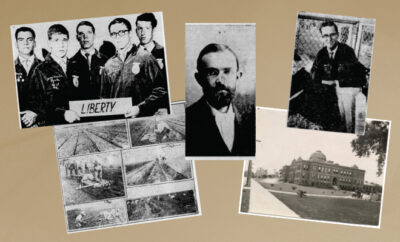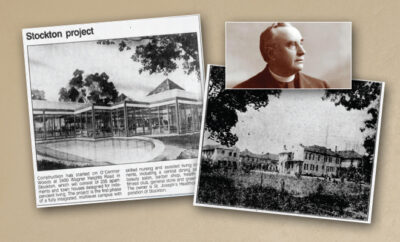 Stockton Historical Society
Stockton Historical Society
Stockton’s Shipbuilding Industries: Significant Contribution to the War Effort
BY PHILLIP MERLO
Stockton, in addition to its unique history as an agricultural and logistics powerhouse, has long distinguished itself among California cities for the magnitude and importance of its manufacturing. During WWII, the city was the largest industrial center in the Central Valley.
To make manufacturing work as a business, you need cheap transportation, access to raw materials and a skilled workforce. The inland California Delta, proximity to the Sierra Nevada, and Stockton Unified’s early 20th century status as one of the top school districts in the country, ensured that manufacturing was a major industry here from the 1890s through the 1950s. Holt Brothers Manufacturing, which developed the tractor, Hickinbotham Brothers, Letourneau Industries and many other firms powered the economy of San Joaquin County.
With so much industrial know-how, it was little wonder that the city would become a major shipbuilding center during the Second World War.
Just eight days after Pearl Harbor, on December 15, 1941, local shipbuilders Stephens Brothers launched their first war vessel for the U.S. Navy. Colberg Brothers completed an identical ship the next day. The first two boats were the YMS 94 and YMS 95, which were minesweepers for the U.S. Navy.
By 1943, Stockton’s wartime industries, centered on the waterfront across from the Port of Stockton, included Stephens Brothers, Colberg Boat Works, Pollock-Stockton Shipbuilding Company, Rheem Manufacturing, Harris Manufacturing, Hickinbotham Shipbuilders, Kyle & Company, Clyde W. Wood, Moore Equipment Company and 195 smaller manufacturing firms, all maintaining robust contracts from the US military-industrial complex for the construction of everything from Minesweepers and Floating Dry Docks, to the wire coat hangers and pencil sharpeners used at US Army bases.
The largest firms were Stockton’s major employers. As of January 1, 1943, 6,700 workers were employed by the city’s wartime manufacturing industries, with total wages exceeding $19,000,000, approximately $32,000,000 today. In the first two weeks of 1943 alone, local firms built 29 ships and barges.
Among the many ships built in Stockton were the aforementioned minesweepers (Stephens Brothers & Colberg Boat Works), large auxiliary floating dry docks (Pollock), barracks, and freight barges (Pollock), tank landing and derrick barges (Hickinbotham), deck and landing barges (Kyle & Co.), seaplane derricks (Moore Equipment Company), landing craft (Moore Equipment Company, notably used in the Pacific Islands campaign), air-sea rescue boats (Stephens Brothers), and rescue and salvage ships (Colberg Boat Works).
By August 1945, the war was over, and Stockton’s major manufacturing concerns were rapidly turning their efforts to postwar construction and conversion to serving civilian needs. Pollock-Stockton Shipbuilding had grown so large that they were able to maintain their Navy contracts. Other firms, such as Rheem Manufacturing, retooled and secured contracts to manufacture oil drums. Stephens-Colberg Yards. a merger, returned to commercial, government and pleasure craft. The number of employees in the manufacturing field went from an approximate high of 12,000 in early 1945 to closer to 4,000 by 1946.










